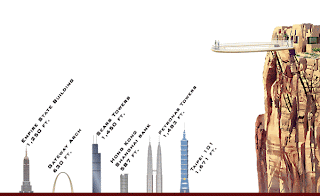Glass-bottomed Skywalk opens over Grand Canyon (28 Mar 07)
 The Glass Bridge Construction of the Skywalk began March of 2004 and will open March 28, 2007.
The Glass Bridge Construction of the Skywalk began March of 2004 and will open March 28, 2007.Upon completion, the Glass Bridge will be suspended 4,000 feet above the Colorado River on the very edge of the Grand Canyon. On May 2005, the final test was conducted and the stucture passed engineering requirements by 400 percent, enabling it to withstand the weight of 71 fully loaded Boeing 747 airplanes (more than 71 million pounds). The bridge will be able to sustain winds in excess of 100 miles per hour from 8 different directions, as well as an 8.0 magnitude earthquake within 50 miles. More than one million pounds of steel will go into the construction of the Grand Canyon Skywalk.

 HUALAPAI INDIAN RESERVATION (Arizona) - A gleaming glass-bottomed walkway that juts out over the edge of the Grand Canyon welcomed its first visitors on Tuesday, with Apollo 11 astronaut Buzz Aldrin taking one small step for man and one almighty leap for sufferers of vertigo.
HUALAPAI INDIAN RESERVATION (Arizona) - A gleaming glass-bottomed walkway that juts out over the edge of the Grand Canyon welcomed its first visitors on Tuesday, with Apollo 11 astronaut Buzz Aldrin taking one small step for man and one almighty leap for sufferers of vertigo. The Skywalk, a horseshoe-shaped observation deck extending 21 metres over the western lip of the vast natural chasm, in the remote Hualapai Indian Reservation, about 193 kilometres east of Las Vegas, Nevada, allows tourists to peer straight down a dizzying 1,220 metres to the canyon floor below, through 10-centimetre thick reinforced glass.
'It felt wonderful,' said Mr Aldrin, the second man to set foot on the moon after Neil Armstrong in the 1969 mission, after strolling around the walkway with members of the Hualapai tribe.
'Not exactly floating on air or walking in space, but it was wonderful. It wasn't the least bit disturbing - at least not for some of us,' he said.
The Hualapai hope the Skywalk will help bring valuable tourist dollars to their impoverished corner of the Grand Canyon.
Architects say the gravity-defying structure is capable of supporting several hundred people simultaneously and will not be affected by powerful winds that often roar through the Grand Canyon.
Weighing roughly 500 tonnes, the walkway is constructed with layer upon layer of reinforced glass and is supported by massive steel bolts that have been driven 14 metres into surrounding bedrock. Giant shock absorbers also will prevent the structure from quivering under the weight of visitors, architects say.
The project, which took two years to complete, is the latest example of Native American tribes seeking to generate income through tourism. The Hualapai are hoping that the Skywalk will persuade visitors to come to their remote section of the Grand Canyon, which previously struggled to lure tourists with its Old West-style villages and tours.
The Skywalk was dreamed up by Shanghai-born businessman David Jin. The Las Vegas-based investor is reported to have bankrolled construction of the 30 million dollar project, and under a deal with the Hualapai, will collect up to half of the revenues from ticket sales over the next 25 years to recoup his investment.
Tickets for the Skywalk, which opens to the public on March 28, will cost about 25 dollars.
But construction of the project has been criticised by some Hualapai members and environmentalists, with several tribal members saying on Tuesday they had mixed feelings about the project.
'I'd say most Hualapai are opposed to it,' said Mr Don Havatone, 46, a tour guide. 'It's hard to accept. It's sacred ground for us and we are disturbing it. But on the other hand I think people will grow to accept it if they can see that our children will benefit from tourism.'
Charlie Vaughn, the chairman of the Hualapai tribal council, said members of the tribe had not complained when the project was first mooted. 'I took that silence to be consent,' Mr Vaughn said.
'I understand people are happy about the environmental impact but when I balance that against what this could mean for our children's future those issues are put into perspective,' he said. -- AFP
Comments